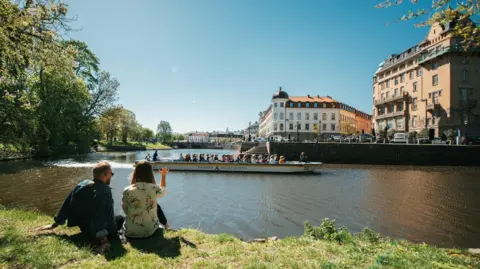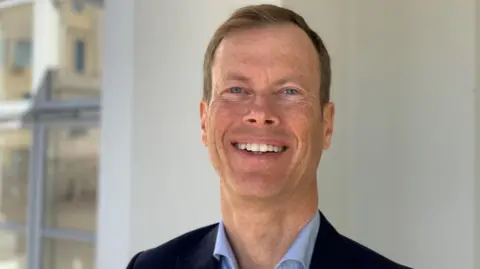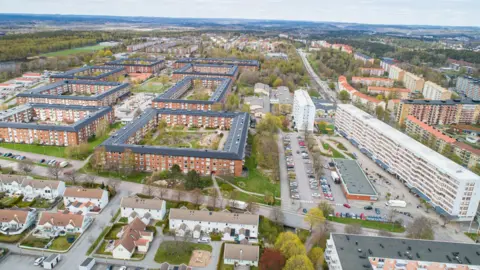Business reporter
 Happy Visuals Goteborg
Happy Visuals GoteborgGothenburg, Sweden’s second city, is highlighting its environmental credentials by continuing to put its money on the line.
Back in 2022, the City of Gothenburg, became what is believed to be the first local government in the world to take out a “sustainability linked loan” or SLL.
This is a form of financing pegged to a set of annual environmental and social improvements agreed between a borrower and its banks.
Gothenburg’s four target areas are efforts to make renewable energy the sole source of the city’s heat production, making the council’s own vehicle fleet electric, reducing energy usage in municipality-owned buildings, such as hospitals and schools, and improving the city’s poorest neighbourhoods.
Meet agreed annual improvement levels in these sectors and, for each, Gothenburg gets a discount on the yearly fee it pays for the loan of 0.1% or around 100,000 kronor ($10,500; £8,000). But miss one of the targets by a certain amount and it has to pay a fine of the same amount.
In 2022 and 2023 Gothenburg managed to avoid a financial penalty, but the newly released figures for 2024 show that it missed its target for switching to renewable energy. And so it is about to be fined 150,000 kroner.
However, this is offset by the discounts it is getting for continuing to hit improvement levels for energy usage and social improvement. For electrifying the council’s vehicles, while it missed its improvement goal, it didn’t do so by enough to be fined.
Fredrik Block, portfolio manager at the City of Gothenburg, says that the local authority deliberately set “ambitious” targets.
“You aim high, and you get the whole organisation to strive towards that target. We are not proceeding as fast as we expected, but we are taking one step at a time. The goal is still to be close to carbon-free by 2030.
“We’re actually not doing it for the money. We’re doing it to show the city’s important work and that we are making progress every year. We want to show to the world how it is – that these are the problems, and these are the good things.”
 Fredrik Block
Fredrik BlockThe improvements to the city’s poorest areas – and whether the council has hit its targets – are measured by yearly resident surveys. People are asked about their feelings towards an area’s safety and cleanliness.
Key initiatives have included making housing more secure, introducing more surveillance cameras and increasing police presence as a crime prevention measure in areas of the city like Hjallbo and Biskopsgarden. Located in the north of the city, they have high levels of crime and unemployment, and large immigrant populations.
Public housing agency Framtiden, which is ultimately owned by the City of Gothenburg, says it takes the improvement work very seriously.
“For some of these vulnerable areas, we actually own the majority of the housing,” says its research and development manager, Lars Bankvall.
“We are more or less the only official body in these areas. There’s no one else there, only us.
“I see us as maybe the most powerful tool that the city has, because we have a lot of financial resources. We are involved in everything.”
But Faduma Awil, a social worker who now provides career coaching at an employment centre in Gothenburg, is concerned that increased cameras and police presence sends the wrong message to youth in Gothenburg’s deprived areas – and could see racial profiling increase.
“What will our children think when they see cameras everywhere in Hjallbo, but none in a Swedish neighbourhood? How will they feel when they are constantly being watched by police?” she says.
“What will you tell them? You are showing them there is a difference between them and native Swedes.”
Ms Awil is also not convinced the resident surveys are effective or accurate. And she feels the city is placing a disproportionate amount of effort into its environmental goals, at the expense of improving conditions in underprivileged areas.
“People in these areas don’t care about the environment. They need to go to school. They need to work. They need to eat,” says Ms Awil, who migrated from Somalia to Sweden in 1987 as a child.
 Jonas Bjorn
Jonas BjornNegotiating an SLL is a rigorous, complex process – one that took the City of Gothenburg a year to do, with no fewer than six major Nordic banks involved.
Such is the difficulty of acquiring an SLL that the number issued globally fell by 56% in 2023, according to data from financial news provider Bloomberg.
Mats Olausson is senior sustainability advisor at Swedish bank SEB, which is the lead lender of Gothenburg’s SLL.
He says SEB has turned down potential SLL borrowers as the client’s proposed targets weren’t ambitious enough. Yet he adds that SLLs are challenging for companies or local authorities that successfully get one.
“It’s sad if a company puts a lot of resources into designing an SLL, and then it turns out that the only publicity they get is negative,” he says. “You run the risk of being pulled into the dirt for having not done a good enough job.
“It’s in no one’s interest to have targets that are overly ambitious and basically impossible to achieve, or for companies who don’t have the right governance in place to implement the actions that will be the building blocks of the actual strategy.”
One company that is happy with its SLL is Danish management consultancy Emagine. It borrowed £10m in 2021, funds that helped it to acquire six other firms around the world.
Its binding goals include increasing the number of female leaders in the organisation by 16%, and reducing overall employee turnover by 6% over the seven-year long period. It is doing this through leadership and mentoring programs.
By meeting the targets, Emagine is benefiting from reduced interest rates, says Lars Bloch, the company’s chief financial officer.
“If we didn’t meet the goals, we would be landed with interest penalty rates. We also accept that failing to meet sustainability targets could harm the firm’s reputation, as we have made a public commitment.
“It shouldn’t be about committing to the loan to get a discount on financing – there needs to be ambition behind the goals.”
Back in Gothenburg, the city’s current environmental and social targets run until 2030. Mr Block says that the detailed yearly SLL reporting shows to potential future investors in the city what a difference their money would make.
“Banks want to give money to sustainable cities, so packaging up our progress in our SLL reporting is how I make the city beautiful for investors,” he says.
“I can’t change the credit worthiness of the city, but I can change how investors look at our sustainability work, and make it more attractive to them.”







